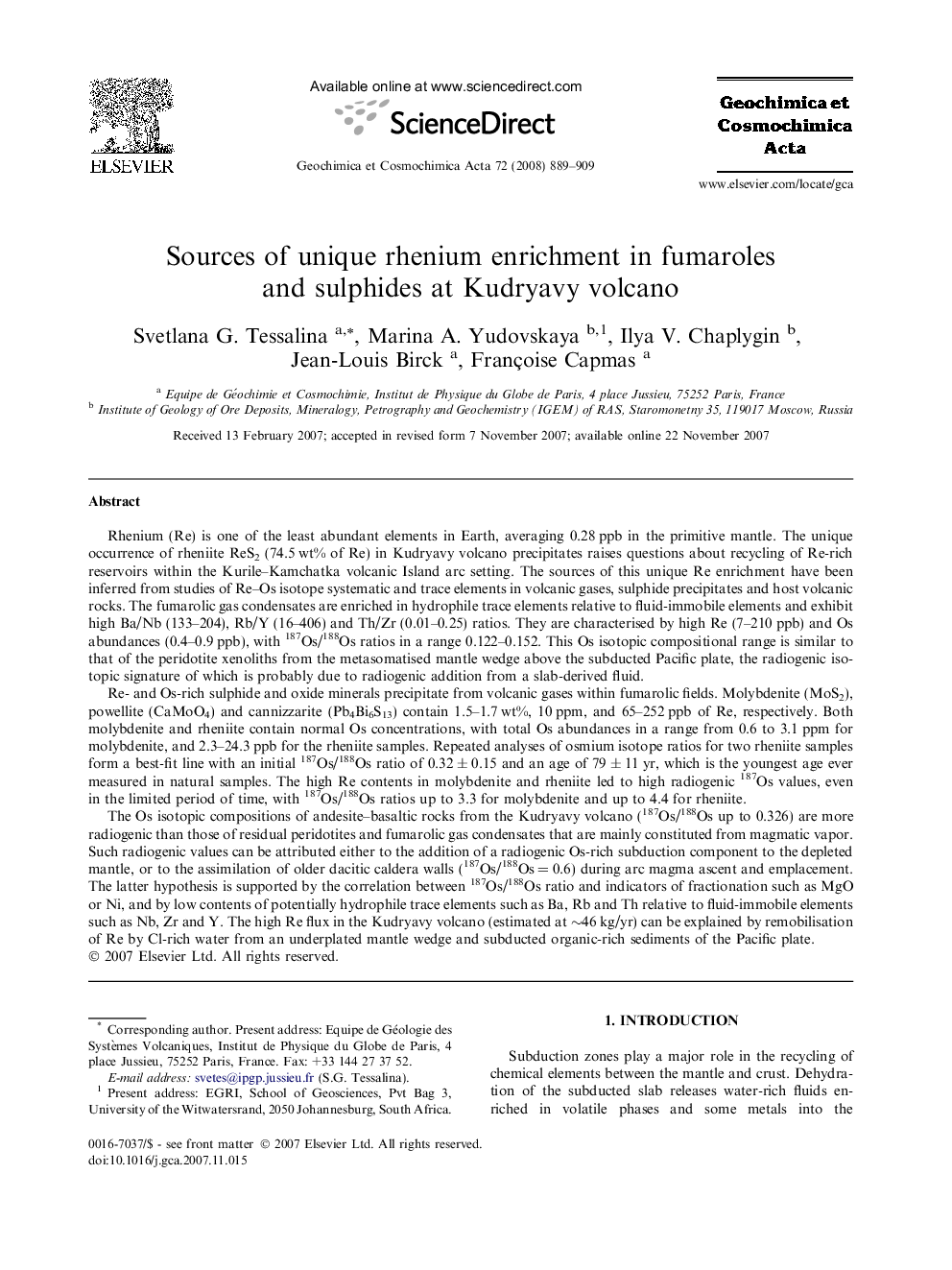| کد مقاله | کد نشریه | سال انتشار | مقاله انگلیسی | نسخه تمام متن |
|---|---|---|---|---|
| 4705190 | 1352946 | 2008 | 21 صفحه PDF | دانلود رایگان |

Rhenium (Re) is one of the least abundant elements in Earth, averaging 0.28 ppb in the primitive mantle. The unique occurrence of rheniite ReS2 (74.5 wt% of Re) in Kudryavy volcano precipitates raises questions about recycling of Re-rich reservoirs within the Kurile–Kamchatka volcanic Island arc setting. The sources of this unique Re enrichment have been inferred from studies of Re–Os isotope systematic and trace elements in volcanic gases, sulphide precipitates and host volcanic rocks. The fumarolic gas condensates are enriched in hydrophile trace elements relative to fluid-immobile elements and exhibit high Ba/Nb (133–204), Rb/Y (16–406) and Th/Zr (0.01–0.25) ratios. They are characterised by high Re (7–210 ppb) and Os abundances (0.4–0.9 ppb), with 187Os/188Os ratios in a range 0.122–0.152. This Os isotopic compositional range is similar to that of the peridotite xenoliths from the metasomatised mantle wedge above the subducted Pacific plate, the radiogenic isotopic signature of which is probably due to radiogenic addition from a slab-derived fluid.Re- and Os-rich sulphide and oxide minerals precipitate from volcanic gases within fumarolic fields. Molybdenite (MoS2), powellite (CaMoO4) and cannizzarite (Pb4Bi6S13) contain 1.5–1.7 wt%, 10 ppm, and 65–252 ppb of Re, respectively. Both molybdenite and rheniite contain normal Os concentrations, with total Os abundances in a range from 0.6 to 3.1 ppm for molybdenite, and 2.3–24.3 ppb for the rheniite samples. Repeated analyses of osmium isotope ratios for two rheniite samples form a best-fit line with an initial 187Os/188Os ratio of 0.32 ± 0.15 and an age of 79 ± 11 yr, which is the youngest age ever measured in natural samples. The high Re contents in molybdenite and rheniite led to high radiogenic 187Os values, even in the limited period of time, with 187Os/188Os ratios up to 3.3 for molybdenite and up to 4.4 for rheniite.The Os isotopic compositions of andesite–basaltic rocks from the Kudryavy volcano (187Os/188Os up to 0.326) are more radiogenic than those of residual peridotites and fumarolic gas condensates that are mainly constituted from magmatic vapor. Such radiogenic values can be attributed either to the addition of a radiogenic Os-rich subduction component to the depleted mantle, or to the assimilation of older dacitic caldera walls (187Os/188Os = 0.6) during arc magma ascent and emplacement. The latter hypothesis is supported by the correlation between 187Os/188Os ratio and indicators of fractionation such as MgO or Ni, and by low contents of potentially hydrophile trace elements such as Ba, Rb and Th relative to fluid-immobile elements such as Nb, Zr and Y. The high Re flux in the Kudryavy volcano (estimated at ∼46 kg/yr) can be explained by remobilisation of Re by Cl-rich water from an underplated mantle wedge and subducted organic-rich sediments of the Pacific plate.
Journal: Geochimica et Cosmochimica Acta - Volume 72, Issue 3, 1 February 2008, Pages 889–909